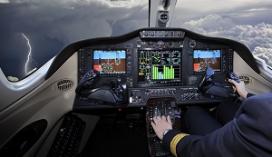Attitude Adjustments Could Prevent Aircraft Accidents
The cause of most aircraft accidents is not mechanical failures or malfunctioning equipment—it’s humans. Pilots can be their own worst enemies, but awareness of common hazardous behaviors can help reduce accidents.
After 32 years of piloting experience, Jack Keenan joined the Federal Aviation Administration (FAA) as an aviation safety inspector. Throughout his career, he examined the human factors that cause accidents, both from a pilot and design perspective.
“In the army, we flew planes that required a pilot to lift his or her head to change frequencies on radios placed above them,” said Keenan, who is now retired from the FAA. “From a human factors perspective, this is very dangerous—not only is it distracting, it can potentially cause vertigo.”
Hazardous Attitudes
 Keenan recently visited Volpe to discuss causal factors in aircraft accidents, with a focus on pilots. He shared case studies in which pilots made a series of poor decisions that led to fatal accidents, from lack of proper communication with air traffic control to misjudging weather conditions.
Keenan recently visited Volpe to discuss causal factors in aircraft accidents, with a focus on pilots. He shared case studies in which pilots made a series of poor decisions that led to fatal accidents, from lack of proper communication with air traffic control to misjudging weather conditions.
Keenan explained that, at the core, these missteps are rooted in emotional behaviors.
“There are five hazardous attitudes that contribute to accidents,” Keenan said. “At least one of these applies to almost every accident, even in instances of technical problems.”
Understanding these behaviors, and their potential danger, can help pilots prevent accidents.
The Five Hazardous Attitudes
- Anti-authority: Regarding rules, regulations, and procedures as unnecessary.
- Impulsivity: Attempting to solve a problem with the first solution that comes to mind, rather than taking time to consider and select the best option.
- Invulnerability: Believing that an accident is unlikely.
- Macho: Taking risks to prove oneself and impress others.
- Resignation: Attributing both positive and negative outcomes to luck, rather than one’s own actions.
Human Factors and Technology
With ever-evolving technology, it is inevitable that human factors will continue to cause accidents. For example, the invention of the global positioning system (GPS) caused some pilots to lose previously ingrained navigation skills and neglect standard procedures. Instead of deviating from the GPS-set path when weather conditions look bad, pilots may continue to follow GPS anyways, rather than avoiding potentially dangerous conditions.
“Technology can do great things,” Kennan said, “but it’s a double-edged sword—it depends on how you use it.”

